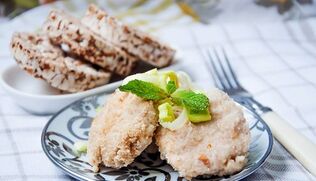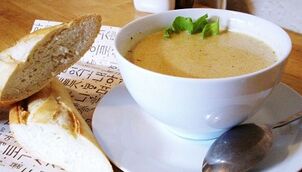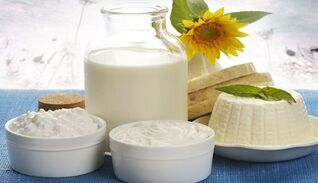
Pancreatitis is a severe pancreatitis, characterized by a violation of the production of digestive enzymes. The main symptoms of the disease are pain after eating in left or right hypotension, heartburn, nausea, vomiting and stomach discomfort.
The key to treating pancreatitis is following dietary guidelines. After all, the development of the disease is often due to improper lifestyle, the use of alcohol and "junk food" in large quantities.
Diet for pancreatitis helps patients reduce pain as the disease worsens and improve remission. In acute and chronic pancreatitis, the nutrition is different but still, it has some similarities. Let's talk about them.
General nutritional rules for pancreatitis
The main requirement of the diet is to increase the amount of protein consumed and reduce fats and carbohydrates in the main diet (if possible, they should be eliminated completely). You should especially stop consuming granulated sugar, as 99% of it is made up of carbohydrates.
Fatty foods high in coarse fiber should be completely eliminated from patients with pancreatitis. After all, they put a lot of strain on the pancreas, because the organ begins to produce very large amounts of digestive enzymes, which is dangerous in this disease and can lead to serious complications.
Doctors recommend that all patients with pancreatitis take vitamin complexes that help fill the body with a lack of vitamins and minerals, often due to limited nutrition.

Meals should be scheduled at the same time.
Eat 5-6 times a day in small portions to avoid overloading the pancreas and overeating.
Diet for acute pancreatitis
Usually, acute pancreatitis appears as a sudden sharp pain in the stomach pit. The pain is unbearable and therefore forces a person to call an emergency car. The diet for acute pancreatitis before the doctor's visit is "zero". In no case should you eat food. Neither "light" nor "heavy".
Before taking your doctor's, it is permissible to take water that is not carbonated, but not more than 3 glasses. And it is permissible to drink them only if urination takes place normally.
Acute pancreatitis is treated only in a hospital. For the first two days, the patient is prescribed fasting. Only now is it allowed to drink rose power broth along with mineral water. The total amount of fluid consumed should not exceed 5 glasses per day.
On the third day of treatment, the patient is allowed to eat fresh, low-calorie foods, which do not contain substances that cause pancreatic irritation and increase secretion.
After the onset of symptoms, the pancreatitis diet continues for one to two months. During this time, you should leave completely:
- fried and fatty foods;
- muffins and pastries;
- pickles and smoked foods;
- pickles and canned food;
- spicy and sweet;
- onion and garlic;
- alcoholic beverages;
- fatty meats and fish;
- sausages.
All food must be heat treated. They should boil in water or steam. Do not use oil, salt and spices when cooking.

The patient is only allowed to eat hot and shredded food. Before going to bed it is recommended to use fermented milk products in laxatives - kefir, fermented baked milk.
The duration of the diet for 6 to 12 months. And that's how a person will relate to what their future health depends on. If all nutritional recommendations are neglected, the disease can take a long-term form and the patient must be treated for the rest of his or her life.
Diet for chronic pancreatitis in remission
A chronic pancreatitis diet is slightly different from the above diet. In this case, the patient's diet is significantly expanded, but only in the remission stage. During the exacerbation period, the diet is very different, but more on that later.
In chronic pancreatitis, protein intake is allowed, which should be almost several times higher than a person's daily intake, and the use of carbohydrates (sugar, honey, baked goods, baked goods, etc. ) is also allowed.
Food that irritates the pancreas (hot spices, large amounts of salt, alcohol, etc. ) is the limitation.
The patient's nutrition should also be in fractions. The number of meals is 4 to 6 times. The food served should be hot. You do not need to grind food before taking it.
Meat and fish products should not be high in fat, otherwise it can cause liver degeneration, which happens quite often with chronic pancreatitis. Cottage cheese contains many useful substances and must therefore simply be present in the patient's diet. However, you can only eat homemade cottage cheese, but not very fatty. It is forbidden to eat cottage cheese.
If a person can not refuse bread, it is recommended that he use either pastry yesterday or biscuits (only made from gray or black bread). You can also eat baked goods and pastries, but in limited quantities (no more than one serving per day).
In case of pancreatitis, it is not advisable to drink milk in its pure form as it is poorly digested. It can be added to tea or made from grains and soups. Even if the patient tolerates milk well, it should not be drunk in large quantities. The maximum dose is 200 ml.

Fermented dairy products are very useful for people with chronic pancreatitis. Even cheese, which in other stages of the disease is on the list of forbidden foods, can be consumed in remission, but not in large quantities and provided you feel good. The cheese should not be very salty or greasy.
Eggs cannot be eaten whole. Only egg whites can be present in the patient's diet. It can be used to steam omelets or add them to soups.
The patient's diet should not be high in fat (not more than 70 g per day). Furthermore, most of them should be made from vegetable fats. They are better digested and do not burden the pancreas.
Diet for chronic pancreatitis with exacerbation
The diet of pancreatitis during exacerbation is the same as in the acute form of the disease. The patient is prescribed fasting and if positive exercise occurs, he is allowed to eat fresh and low-fat foods in small amounts.
If health problems are not observed, the patient's menu gradually expands. After 2-3 months, the person can eat in the same way as in remission.
Remember, this is just a rough diet for pancreatitis. The entire list of authorized and prohibited products should be reviewed by your doctor. Only he can compose the right diet taking into account your health.














































































